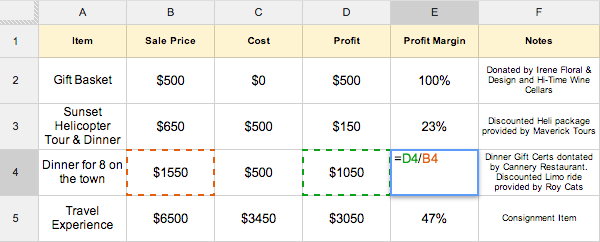
After a year’s worth of planning, your fundraising auction is finally over – but the work doesn’t stop just yet! Now is the time to look back on your auction and evaluate your success by following these three steps.
1. Analyze financial reports
The best way to determine if your fundraising event was successful is to look at your financial reports. Did you meet or surpass your fundraising goal? How did this year’s revenue compare to last year’s? Did you go over budget in any area?
Once you have an idea of how the event performed overall, take a look at how profitable your various charity auction items were. A quick and easy way to do this is to put all the items in a spreadsheet and include a column for Sale Price, Cost, Profit and Profit Margin.

Sale Price: The amount the donor paid for the item
Cost: How much it cost you to acquire the item
Profit: (Sale Price) – (Cost)
Profit Margin: (Profit)/(Sale Price)
Notes: Who donated what and where you incurred costs
List all your items, fill in the columns with the appropriate amounts and calculate the profit margin for each item. The higher the profit margin, the more profitable the item. Items that are completely donated will always have a 100% profit margin.
Make sure to also list items that didn’t sell, as well as any costs associated with them. This information will be useful when meeting with your team in step two.
2. Meet with your auction team
Successful or not, it’s always important to analyze what went well and what didn’t go very well in order to improve next year’s fundraising event. Set up a post-auction meeting with your auction committee and ask for feedback, both positive and negative.
Open a discussion about everything from the party venue to the table arrangements. All aspects of the event should be open for discussion. Whenever there is negative feedback, be proactive and take time during the meeting to start generating solutions.
Also take some time to review the excel sheet you prepared with the profit margin for each item. Go down the list and highlight the items that were the most profitable. For items with low profit margins, take note how much profit was generated. Some items may have lower profit margins but still contributed a significant amount overall, which is still worth your time. Items with low margins that were difficult to acquire and raised less than a couple hundred dollars you might consider removing from the next event.
3. Survey donors
Ask your donors for feedback is another great way to pinpoint problems or areas the need improvement. Create a survey using a free online resource like SurveyMonkey and place a link to your survey in a post-event email you send out to the entire guest list.
Keep the survey short (7-10 questions at most) so it can be completed in less than 5 minutes. Include a final comments section where respondents can leave more feedback. Once you have their answers, show donors that you value their opinion and incorporate some of their suggestions into future event planning.
{{cta(‘f8b88efb-996c-4a27-a083-ab2a10e71f96’)}}
After your fundraising auction, it is crucial that you and your team take the time to reflect on the event and work to make future improvements. You will thank yourself later, I promise!
{{cta(‘ebf89866-1f26-452b-89ce-5c7db60aa6bd’)}}
